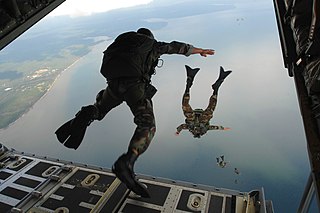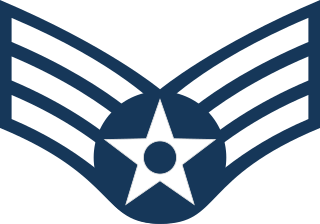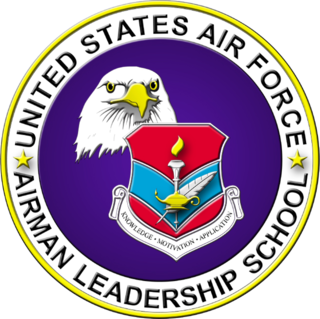Related Research Articles

The United States Air Force (USAF) is the air service branch of the United States Armed Forces, and is one of the eight uniformed services of the United States. Originally created on 1 August 1907, as a part of the United States Army Signal Corps, the USAF was established as a separate branch of the United States Armed Forces in 1947 with the enactment of the National Security Act of 1947. It is the second youngest branch of the United States Armed Forces and the fourth in order of precedence. The United States Air Force articulates its core missions as air supremacy, global integrated intelligence, surveillance and reconnaissance, rapid global mobility, global strike, and command and control.

Airman basic (AB) is the lowest enlisted rank in the United States Air Force immediately below airman. The pay grade for airman basic is E-1.

An airman is a member of an air force or air arm of a nation's armed forces. In certain air forces, it can also refer to a specific enlisted rank. An airman can also be referred as a soldier in other definitions.
The chart below represents the current enlisted rank insignia of the United States Air Force.

Senior airman (SrA) is the fourth enlisted rank in the United States Air Force, just above airman first class and below staff sergeant. It has a pay grade of E-4. Between its approval on 30 December 1975 and 19 March 1991, senior airmen wore sleeve chevrons with blue center stars instead of silver to distinguish them from the non-commissioned officer rank of "sergeant", also a pay grade of E-4. The latter was abolished in 1991 and the blue center star was changed to white to conform to all enlisted rank chevrons.
Senior master sergeant is the military rank for a senior non-commissioned officer in the armed forces of some countries.
An Enlisted Performance Report (EPR) is an evaluation form used by the United States Air Force. Instructions for constructing an EPR appear in chapter 3 of Air Force Instruction 36-2406: Officer and Enlisted Evaluation Systems. The EPR replaced the Airman Performance Report (APR) in the late 1980s.
Specialist is a military rank in some countries' armed forces. Two branches of the United States Armed Forces use the rank. It is one of the four junior enlisted ranks in the United States Army, above private (PVT), private (PV2), and private first class and is equivalent in pay grade to corporal; in the United States Space Force, four grades of specialist comprise the four junior enlisted ranks below the rank of sergeant.
The Weighted Airman Promotion System (WAPS) is a United States Air Force program that determines promotions to the ranks of Staff Sergeant (E-5) through Technical Sergeant (E-6). It provides feedback score sheets to enlisted members considered for promotion, which help members to focus on specific professional development needs. Selections for promotion to Master Sergeant (E-7), Senior Master Sergeant (E-8), and Chief Master Sergeant (E-9) utilize an integrated weighted and central selection board system. In addition to the weighted score, the central selection board evaluates each individual using the whole person concept. Board scores are determined by considering performance, leadership, breadth of experience, job responsibility, professional competence, specific achievements, and education. The board score is added to the weighted score to determine order of merit for promotion.

Airman Leadership School (ALS) is a 24 duty day United States Air Force program designed to develop airmen into effective front-line supervisors. It is the first professional military education that enlisted Air Force members encounter. ALS focuses on developing leadership abilities, the profession of arms, and building effective communication. ALS was established in the 1990s, replacing the Non-commissioned Officer (NCO) Preparatory Course and NCO Leadership School.
In the United States Armed Forces, a major general is a two-star general officer in the United States Army, Marine Corps, Air Force, and Space Force.

United States Air Force Basic Military Training is a seven-week program of physical and combat training required in order for an individual to become enlisted into the United States Air Force, Air Force Reserve, Air National Guard and United States Space Force. It is located at Lackland Air Force Base in San Antonio, Texas.

Airman first class (A1C) is the third enlisted rank in the United States Air Force, just above airman and below senior airman. The rank of airman first class is considered a junior enlisted rank, with the non-commissioned officers and senior non-commissioned officers above it.
In the United States Army (USA), U.S. Marine Corps (USMC), U.S. Air Force (USAF), and U.S. Space Force (USSF), captain is a company-grade officer rank, with the pay grade of O-3. It ranks above first lieutenant and below major. It is equivalent to the rank of lieutenant in the Navy/Coast Guard officer rank system and is different from the higher Navy/Coast Guard rank of captain. The insignia for the rank consists of two silver bars, with slight stylized differences between the Army/Air Force version and the Marine Corps version.

The United States Air Force Physical Fitness Assessment (PFA) is designed to test the body composition, muscular strength/endurance, and cardiovascular respiratory fitness of airmen in the United States Air Force. As part of the Fit to Fight program, the Air Force adopted a more stringent physical fitness assessment in 2004 and replaced the annual ergo-cycle test that the Air Force had used for several years. Results are stored in the Air Force Fitness Management System (AFFMS) and accessible via the AF Portal.
Members of Civil Air Patrol are assigned various ranks, the titles and insignia of which are based on those used by the United States Air Force. Each grade and insignia corresponds to an equivalent United States Air Force enlisted rank insignia and an equivalent officer rank insignia.